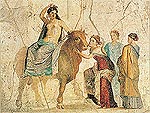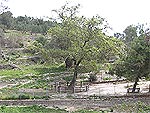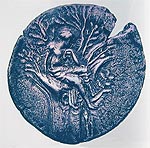| Crete is situated as the outermost bastion in the
Greek area, and from the earliest times when man, or perhaps prehistoric
man, invented to sail, the island has been a focal point between Asia,
Africa and Europe. Therefore the cultures of the three worlds melted
together here and developed into new, exciting and sometimes highly
contrasting forms. |
|
|
|
|
|
| Already in ancient Greek mythology we find a
poetical myth of such a fusion, namely, how Europa came to Europe. |

|
|
|
|
|
|
 |
The
beautiful and wide-browed Europa was the daughter of King Aginoras of
Phoenicia (the current Lebanon / Syria). Zeus fell in love with her and
turned into a white bull, while he approached the girl,
who
was picking flowers on the beach. She was tempted by the beauty and
peacefullnes
of bull, so
she
began to caress it and finally sat on the its back. Immediately Zeus
returned swiftly to Crete with her, and they united under the
evergreen plate tree
in Gortyna. The result of their love became the
three sons Minos, Radámanthys and Sarpidon. Minos became later on King of
Crete. |
|
|
|
|
|
| Since the first mention of a king named Minos dates
from the 15th century BC, we get an approximate date of the abduction. |
|
|
|
|
|
| But
who was Europa
actually? Her grandfather was Poseidon himself, the god of the sea, and
her grandmother Libya. They got two twin sons, one of whom became king of
North Africa and the other of Phoenicia, so in this way Cretan mythology
unites the great cultural centers of those two areas in an elegant way. |

|
|
|
|
Coin from
Gortyna
(3rd century BC),
showing Europa
sitting in the plane tree |
|
|
|
|
|
| At the time that
Zeus
and Europa had their short-lived affair, Asteríon (or Astérios)
was King of Crete. |
|
|
|
|
|
| Zeus
soon left Europa, but before he made sure that she married Asteríon,
who also adopted her three sons, as he did not have children himself. |
|
|
|
|
|
|
|
|
|
|
|
|
|
